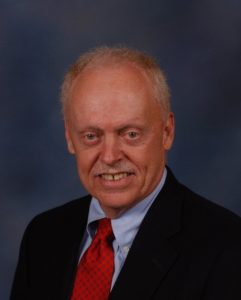
Professor
Ph.D., Harvard University
Office: 501-296-1438
Lab: 501-296-1439
Email: JenningsMichaelL@uams.edu
My Ph.D. was in biophysics in the laboratory of A.K. Solomon, followed by a postdoctoral fellowship with Hermann Passow in cell physiology. In both laboratories, my work focused on membrane biology and the red blood cell inorganic anion exchange protein (Band 3; AE1; SLC4A1). AE1 has been used widely as a model system for the study of the molecular basis of ion transport. In my faculty positions at the University of Iowa, the University of Texas Medical Branch (UTMB), and the University of Arkansas for Medical Sciences (UAMS), I continued to work on AE1 and was supported on this project for nearly 30 years by NIH R01 GM026861.
In the late 1980s, I expanded my studies of coupled ion transport to include the regulation of cation-chloride cotransporters, especially the K+/Cl– cotransporter (SLC12) in connection with red blood cell volume control. This work was supported by NIH R01 HL037479 for 10 years.
More recently I have focused on coupled ion transporters in relation to human disease, including the diastrophic dysplasia SO4= transporter DTDST (SLC26A2) and related SO4= transporters in S. cerevisiae. The yeast studies led to work on the sole S. cerevisiae SLC4 family member, which is a boric acid transporter. The boron transport work led to an R21 grant with Mark Parker of Case Western Reserve University on SLC4A11, which was reported to be a boron transporter. Mutations in SLC4A11 cause clouding of the cornea. Mark Parker and I were co-PI’s of the R21 but we agreed that he would continue the project as independent investigator, which he is now doing as a tenured faculty member at the University of Buffalo.
Starting in 2013-2014, my time and effort shifted away from research because of new responsibilities. I was appointed Executive Associate Dean for Basic Sciences in the College of Medicine, and I was also appointed Director of the new Cardiovascular, Renal, and Pulmonary education module for second-year medical students. In addition to increased administration, I also did more classroom teaching because I took over much of the cardiovascular material that had been taught previously by a retired faculty member. The time required for these activities, in addition to being the department chair, had a significant impact on my research program, but I have been able to continue collaborative studies.
After stepping down as department chair in July 2020, my main activities will be teaching, curriculum development, and educational administration, but I hope to continue to collaborate on research projects as a part-time faculty member.
